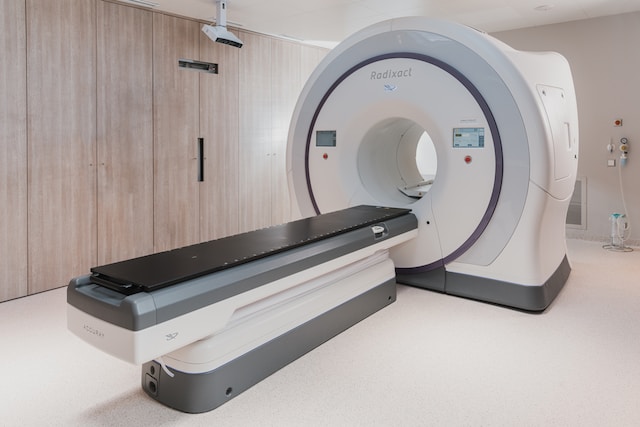
27 May The Evolution of CT Scans: From Early Development to Modern Applications
CT scans, also known as computed tomography scans, have revolutionized medical imaging since their early development. In this article, we will explore the journey of CT scans from their inception to their modern-day applications. We will delve into the early development of CT scans, advancements in technology, the role of CT scans in medical imaging, their applications in emergency and veterinary medicine, and the future trends in this field.
Introduction
CT scans are non-invasive medical imaging procedures that generate detailed cross-sectional images of the body. They provide valuable insights into the internal structures, aiding in the diagnosis, treatment, and monitoring of various medical conditions. Let’s explore how CT scans have evolved over time and the impact they have had on healthcare.
Early Development of CT Scans
2.1 Invention of the CT Scan
The invention of the CT scan can be attributed to the work of British engineer Godfrey Hounsfield and South African physicist Allan Cormack in the early 1970s. Their pioneering efforts led to the development of the first commercially viable CT scanner, which utilized a computer algorithm to reconstruct cross-sectional images from X-ray measurements.
2.2 Initial Applications
Initially, CT scans were primarily used for head imaging, allowing for the detection of brain tumors, hemorrhages, and other neurological conditions. As technology advanced, CT scanners became more versatile and capable of imaging other parts of the body, such as the chest, abdomen, and pelvis.
Advancements in CT Scan Technology
3.1 Multi-Slice CT Scanners
One significant advancement in CT scan technology was the introduction of multi-slice CT scanners. These scanners incorporated multiple detector arrays, enabling the acquisition of multiple image slices in a single rotation. This improved scan speed, spatial resolution, and the ability to perform advanced imaging techniques such as 3D reconstructions and angiography.
3.2 Cone Beam CT Scans
Cone Beam CT scans emerged as a specialized form of CT imaging, particularly useful in dental and maxillofacial applications. This technology utilizes a cone-shaped X-ray beam and a two-dimensional detector to capture volumetric data. Cone Beam CT scans provide highly detailed images for precise diagnosis and treatment planning.
Role of CT Scans in Medical Imaging
4.1 Diagnosis and Treatment
CT scans play a crucial role in diagnosing various medical conditions, including fractures, infections, and tumors. The detailed images obtained from CT scans aid in accurate diagnosis, enabling healthcare professionals to devise appropriate treatment plans.
4.2 Surgical Planning
In surgical fields, CT scans are invaluable tools for preoperative planning. Surgeons can visualize the anatomy in detail, identify potential risks, and determine the optimal approach. This enhances surgical precision, reduces complications, and improves patient outcomes.
4.3 Cancer Detection and Monitoring
CT scans are extensively utilized in cancer diagnosis, staging, and treatment monitoring. They enable the visualization of tumors, evaluation of metastasis, and assessment of treatment response. The ability to track tumor progression and therapeutic efficacy greatly influences patient management decisions.
CT Scans in Emergency Medicine
In emergency medicine, CT scans have become indispensable for rapid and accurate diagnosis of traumatic injuries, such as head trauma, fractures, and internal bleeding. The speed and accuracy of CT scans aid in swift decision-making, leading to timely interventions and potentially saving lives.
CT Scans in Veterinary Medicine
The benefits of CT scans extend beyond human medicine; they have found a valuable place in veterinary practice as well. CT scans in veterinary medicine enable detailed imaging of animals, aiding in the diagnosis and treatment of various conditions, including musculoskeletal disorders, tumors, and neurological diseases.
Future Trends in CT Scan Technology
The future of CT scan technology holds exciting possibilities. Ongoing research and development focus on improving image quality, reducing radiation exposure, and enhancing the efficiency of scanning processes. Advancements such as spectral imaging and artificial intelligence integration are poised to further enhance the diagnostic capabilities of CT scans.
Conclusion
From their humble beginnings to their widespread use in modern medicine, CT scans have revolutionized medical imaging. They have transformed the way we diagnose, treat, and monitor various medical conditions. With continued advancements in technology, CT scans will continue to play a pivotal role in healthcare, ensuring accurate diagnoses and improving patient outcomes.
FAQs
- Are CT scans safe? CT scans involve exposure to X-ray radiation, but the benefits generally outweigh the risks. The radiation dose is kept as low as reasonably achievable, and the diagnostic benefits often outweigh the small potential risks.
- Are CT scans painful? CT scans are painless and non-invasive. You will be required to lie on a table that moves through the scanner, and the process is usually quick and comfortable.
- Can pregnant women undergo CT scans? CT scans use X-rays, which involve radiation. It is generally recommended to avoid unnecessary exposure to radiation during pregnancy. However, in some cases, the benefits may outweigh the risks, and the decision should be made in consultation with a healthcare professional.
- How long does a CT scan take? The duration of a CT scan can vary depending on the area being scanned and the complexity of the examination. Typically, the procedure takes only a few minutes, but it may take longer if multiple scans or contrast agents are involved.
- How often can someone have a CT scan? The frequency of CT scans depends on the individual’s medical condition and the necessity of follow-up imaging. Healthcare professionals will determine the appropriate timing for repeat scans based on the specific circumstances.



